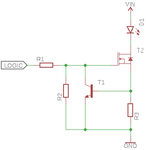jelezarov
Member level 1
Hi,
I have a couple of power-LED's, which I intent to control with an Arduino (not directly, with transistors), to achieve chase lights or other patterns. After trying different resistors, I gave up because of the heat problems. I found following circuit in an ON Semiconductor application brief:

Now, where should the controlling transistor go - in series with the LED, or turning the complete driver on/off?
Other suggestions are of course most welcome.
I have a couple of power-LED's, which I intent to control with an Arduino (not directly, with transistors), to achieve chase lights or other patterns. After trying different resistors, I gave up because of the heat problems. I found following circuit in an ON Semiconductor application brief:

Now, where should the controlling transistor go - in series with the LED, or turning the complete driver on/off?
Other suggestions are of course most welcome.


